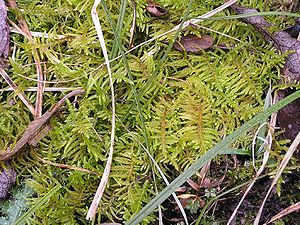Common green stem moss
| Common green stem moss | ||||||||||||
|---|---|---|---|---|---|---|---|---|---|---|---|---|

Pseudoscleropodium purum |
||||||||||||
| Systematics | ||||||||||||
|
||||||||||||
| Scientific name | ||||||||||||
| Pseudoscleropodium purum | ||||||||||||
| ( Hedw. ) M. meat. |
The common green stem moss ( Pseudoscleropodium purum , Syn .: Scleropodium purum (Hedw.) Limpr.) Is a moss from the family of short-rifled mosses and the only species of the genus Pseudoscleropodium .
It is a very typical forest floor moss, which is particularly characteristic of young, afforested forests. It prefers to grow in nutrient-rich, man-made locations and is heavily promoted through reforestation. At the moment the moss is reproducing largely vegetatively. Fruiting stands have only been observed very rarely in recent times, which is probably caused by the strong air pollution.
features
It often forms extensive lawns of up to 15 cm long trunks. These are relatively regularly pinnate, which gives the moss a rather striking appearance. The color varies between yellow-green, brown-green, grass-green and dark green.
The leaves are broadly ovate and have a short tip at the front. The leaf veins, which reach approximately to the middle of the leaf, are forked or double from the bottom. The leaves are clearly hollow and lie on top of each other along the stem so that a closed cavity is created below them. This makes the stems look worm-shaped or swollen. It is assumed that water can be conducted along in this cavity by capillary action .
Overall, this moss resembles the red stem moss ( Pleurozium schreberi ) in habit . In this case, however, the stem itself is clearly discolored red, while in the case of green stem moss the stem always has the same color as the rest of the plant, but never shimmers reddish through the leaves.
distribution
The common green stem moss occurs mainly in forests and on the edges of forests. It is considered a pointer type for nitrogen-rich forest soils. In general, it prefers acidic loamy or sandy soils. It can form mass populations at suitable locations.
It is common across the northern hemisphere as well as New Zealand and parts of Africa . In Central Europe it is widespread and often found from the lowlands to the tree line.
Biomonitoring
The common green stem moss is able to accumulate heavy metals and nitrogen. Since the nitrogen concentration in the moss tissue correlates with the nitrogen deposition or the nitrogen concentration in rainwater, it is used for active biomonitoring . A procedure for recording the regional nitrogen deposition using common green stem moss was standardized with the VDI guideline VDI 3957 sheet 19 .
literature
- Martin Nebel, Georg Philippi (ed.): The mosses of Baden-Württemberg. Volume 2: Special part, (Bryophytina II, Schistostegales to Hypnobryales). Ulmer, Stuttgart 2001, ISBN 3-8001-3530-2 .
- Wolfgang Frey , Michael Stech, Eberhard Fischer: Bryophytes and Seedless Vascular Plants (= Syllabus of Plant Families. 3). 13th edition. Borntraeger, Berlin et al. 2009, ISBN 978-3-443-01063-8 .
Web links
- Common green stem moss in the moss flora of Switzerland
- Pseudoscleropodium purum at www.bbsfieldguide.org.uk
- Pseudoscleropodium purum at www.mobot.org
Individual evidence
- ↑ VDI 3957 sheet 19: 2009-12 Biological measurement methods for determining and assessing the effects of air pollution (bioindication); Detection of regional nitrogen deposits with the deciduous moss Scleropodium purum and Pleurozium schreberi (Biological measurement procedures to determine and assess the effects of ambient air pollutants (bioindication); Detection of regional nitrogen depositions with the mosses Scleropodium purum and Pleurozium schreberi). Beuth Verlag, Berlin, pp. 3–5.
- ^ Karsten Mohr: Biomonitoring of nitrogen deposition with mosses. In: Hazardous substances - cleanliness. Air. 74, No. 6, 2014, ISSN 0949-8036 , pp. 263-265.

